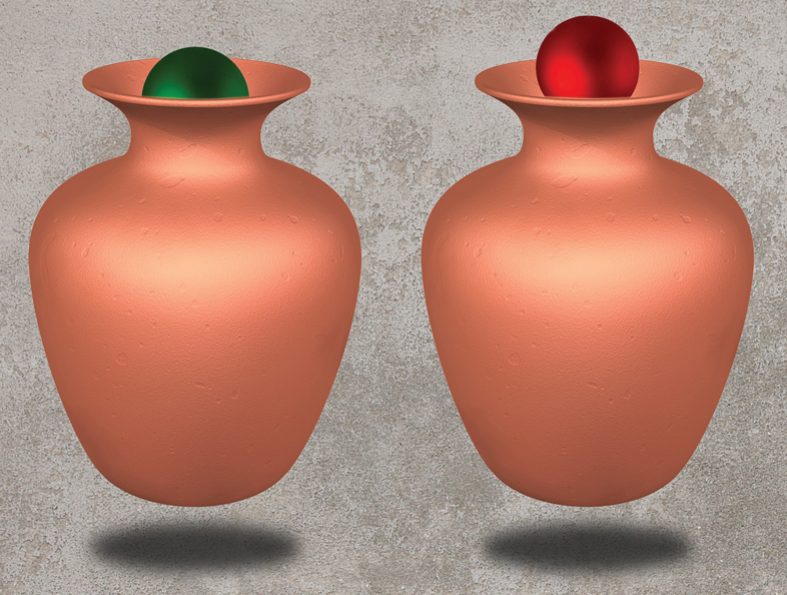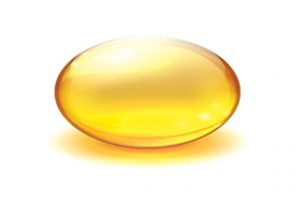By Stephen Meskin
Combinatorial problems are often posed using urns into which balls are placed and then withdrawn. Urns are somewhat mysterious; they can be envisioned as a dark vase with a large round bottom coming to a small opening at the top—just large enough to put in or take out a ball. When a ball is taken out of an urn, we say it is drawn.
Typically, one cannot see into an urn and the balls are identical except for their color, making the draws random. Urns and balls are used to introduce and model problems in combinatorics and elementary probability as in Problem 1. Urns and balls have the magical power to transform themselves into other things. For example, in Problem 2, the urn becomes a pond and balls become fish. In Problem 3, the urn becomes a bag.
Problem 1. (Halmos) One hundred balls, 50 red and 50 green, are distributed between two urns. An urn is selected at random; and from it, a ball is drawn at random. Does the probability of getting a red ball this way depend on how the balls were distributed between the two urns? Justify your answer.
Problem 2. (Steinhaus) An ichthyologist wanted to estimate the number of fish in a pond that were suitable for catching. She threw a net with regulation-size mesh into the pond; after taking the net out, she found 30 fish in the net. Making sure to keep them alive, she marked each of them with a suitable color and threw them all back into the pond. The next day she threw the same net into the pond and caught 40 fish, of which 2 had been marked. Approximately how many fish were in the pond? Justify.
Problem 3. (Honsberger) There are 6 red balls and 8 green balls in a bag. Five balls are drawn at random and placed in a red box; the remaining 9 balls are put in a green box. What is the probability that the number of red balls in the green box plus the number of green balls in the red box is not a prime number? Justify.
Solutions may be emailed to cont.puzzles@gmail.com. In order to make the solver list, your solutions must be received by February 1, 2023.
Solution to Previous Puzzles—Poker Is Back!
1. What is the smallest non-zero equity one can have in a $100 pot? If I hold pocket aces, and my opponent holds the 6 and 7 of hearts, and the flop is 8 of hearts, 9 of hearts and 10 of hearts, then the only way I can even get a split pot is if exactly the jack of hearts and queen of hearts show up on the final 2 cards. This creates an equity for me of $100 × (2/45) × (1/44) = 0.5—which is right around five cents.
2. Can three 10’s ever be the nuts? What is the worst hand that can possibly be the nuts? Three 10’s cannot be the nuts. To see why, if we assume it is the nuts, then none of the five community cards can be higher than a 10, or else a bigger three of a kind is possible. But with five community cards of 10 or smaller, a straight would be possible. Hence there will always be a better hand than three 10’s.
The worst hand that is possibly the nuts is three queens on a board of Q, 8, 7, 3, 2 where no flush is possible.
3. If you are leading on the turn, what is the lowest probability you have of winning the hand? If we only count the times where one loses the entire pot, then if I have the 2 of spades and 2 of clubs, my opponent has the jack and queen of diamonds, and the board is 9 of diamonds, 10 of diamonds, 10 of clubs and 5 of clubs, then my opponent would win with any 8, 9, jack, queen, king, 5, or any diamond that isn’t a 2. The total number of outs is 4+3+3+3+4+3+5=25. So my opponent wins (25/44), or 56.8% of the time.
If we consider it a half of a loss if there is a split pot, then if I have the 5 and 4 of clubs and my opponent has the 3 and 2 of hearts, and the board is 10 of hearts, jack of hearts, queen of diamonds, and king of diamonds, then I only wins if a nonheart 4 or 5 shows up (four cards); I lose if a heart, 2, or a 3 appears (15 cards); and we split the pot on the remaining 25 cards. My opponent’s win percentage is therefore (44-4-12.5) / 44 = 62.5%.
Solvers
Andy Boyer, Rui Rui Gio, Clive Keating, Tim Krahe, David Promislow, Gregory Scruton, Jeff Scwarze, Noam Segal, Russell Spinner, Mark Spong, Al Spooner, and David Stimpson.





